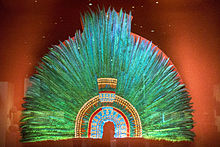Montezuma's headdress
| Moctezuma's headdress | |
|---|---|
Museum of Ethnology, Vienna , Austria | |
| Identification | 10402VO |

Moctezuma's headdress is a
Description
The feathers of the piece have deteriorated over the centuries. It is 116 cm (46 in) high and 175 cm (69 in) across and has the form of concentric layers of different colored feathers arranged in a semicircle. The smallest is made from blue feathers of the
Though it likely served as a headdress, it has also been identified in other ways. As a headdress, its appearance matches that which is seen in contemporary
History

Although attributed to Moctezuma and the Spanish conquest, the provenance of the piece is unattested, and it does not match Aztec illustrations of the headdress of their nobility. It became an object of interest to European researchers such as
Although artifact exchanges and
See also
- Xokonoschtletl Gómora — Mexican activist who has struggled for the return of Moctezuma's headdress.
References
- ^ ISBN 9781607322412.
- ^ Johnson, Kayla (2021-08-17). "Austria Should Repatriate the Mexica Headdress". Hyperallergic. Retrieved 2024-04-12.
- ^ Rodríguez, Ana Mónica. "El penacho de Moctezuma es una capa de sacerdote, afirma un investigador", La Jornada, versión electrónica Archived 2009-06-08 at the Wayback Machine
- ^ Zelia Nuttall:Sur le quetzal-apanecaiotl ou coiffure Mexicaine en plumes conservée à Vienne. En: Congrès International des Américanistes, Paris 1890. Paris 1892. S. 453-459
- ^ "Mexico and Austria in dispute over Aztec headdress". prehist.org. 22 November 2012. Archived from the original on 29 November 2014. Retrieved 24 November 2012.
- ISSN 1134-6582. Retrieved 2022-08-05.
- ^ "Cómo terminó en Austria el penacho de Moctezuma que AMLO reclama al país europeo". BBC News Mundo (in Spanish). Retrieved 2024-04-12.
External links
- Propuesta de trueque histórico por el Penacho
- "El penacho de Moctezuma es un atavío para la cabeza", nota de prensa emitida por el Conaculta
- "El penacho de Moctezuma es una capa de sacerdote, afirma un investigador", a letter in the journal La Jornada
- "Discutirá el Parlamento de Austria si devuelve el penacho de Moctezuma", in the journal La Jornada
- "Ve Austria difícil devolver penacho de Moctezuma", on Esmas.com
- "¿De quien es el penacho de Moctezuma?", by Carmen Cook de Leonard
- http://www.yankuikanahuak.o-f.com/Xoko.htm
- http://www.thehistoryblog.com/archives/16445
